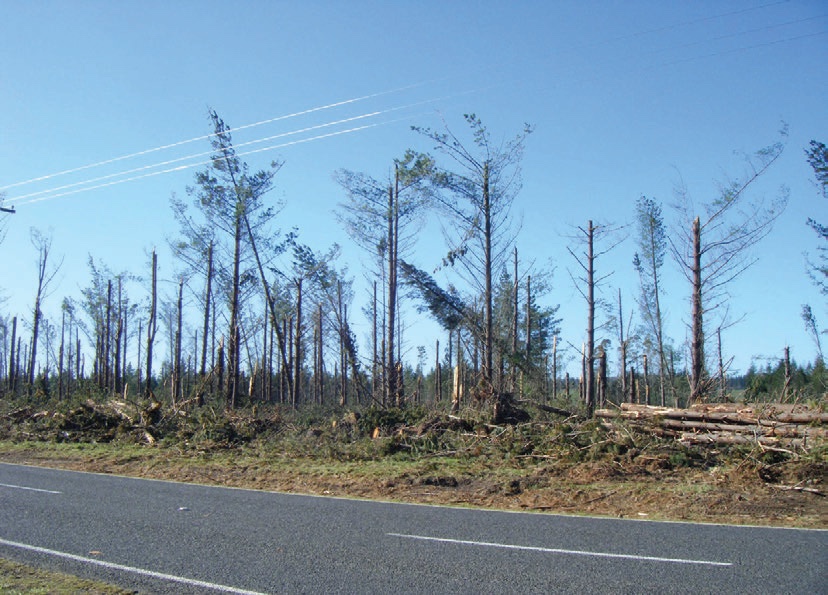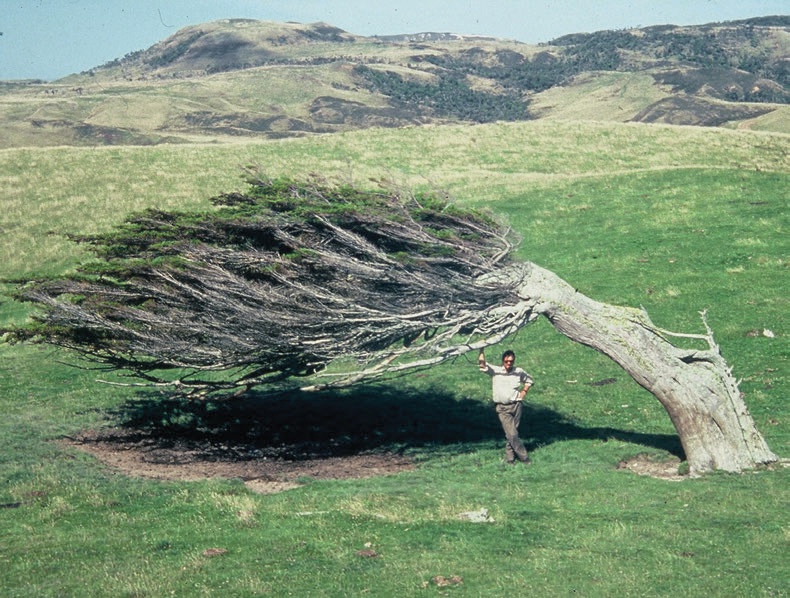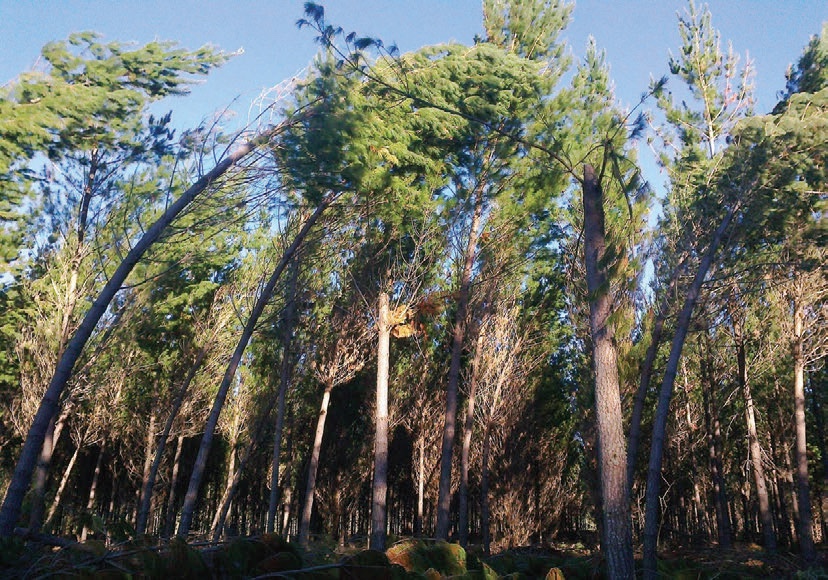Wind damage to forests and the consequences
John Moore, New Zealand Tree Grower August 2014.
The Easter storms resulting from the remnants of Cyclone Ita reminded us of the destructive power of wind. Damaging storms are nothing new in New Zealand and historical records have documented at least 65,000 hectares of damage to planted exotic forests since 1945. Much of this damage occurred in notable events such as the 1975 gale in Canterbury and Cyclones Bola and Bernie which affected the central and upper North Island in the 1980s.
However, there have been a number of recent significant events in the lower North Island and upper South Island, and of course there were the destructive storms in Canterbury in September 2013. This provides some context but the real questions of interest are the consequences of wind damage, and what can tree growers do to manage the risk of wind damage. In this article I attempt to answer these two questions and summarise some of the knowledge that has been gained from over 30 years of research in this area.
Consequences of wind damage
The destructive effects of wind range from wide-scale damage to thousands of hectares of forests through to branch and foliage loss on isolated trees. These large catastrophic events are relatively rare, with some of the most significant events shown in the table. The extent of damage from the two most recent events in 2013 and 2014 is still being assessed, but early data from the 2013 gale in Canterbury indicates that over 2,000 hectares were damaged and more than 500,000 cubic metres of timber was salvaged.
How often would we expect to see these larger storms? Colleagues at the University of Canterbury and I have compiled a list of all known and documented wind damage – there are nearly 80 of these. The median area damaged in a single event is about 90 hectares, but this would have significant consequences for smaller woodlot owners if some or all of this 90 hectares was in your forests. Based on our analysis we calculated
that the return period for 1,000 hectares of damage is about once every six years, while the 11,000 hectares of damage which occurred in Canterbury in 1975 was a one-in-50-year event.
| Year | Event | Regions | Area affected in hectares |
|---|---|---|---|
| 1964 | North west gales | Canterbury | 4,500 |
| 1968 | Wahine storm | Canterbury and Nelson | 2,000 |
| 1975 | North west gales | Canterbury | 11,000 |
| 1982 | Cyclone Bernie | Central North Island | 5,000 |
| 1988 | Cyclone Bola | Central and upper North Island | 26,000 |
| 2004 | South west gales | Southern North Island & Nelson | 3,800 |
| 2008 | 'Weather bomb' | Southern North Island & Nelson | 1,900 |
| 2013 | North west gales | Canterbury | Still being assessed |
| 2014 | Cyclone Ita | West Coast but widespread | Unknown |
After these larger storms, harvesting crews work to try to salvage as much wood as possible, but despite their best efforts there are a number of direct economic consequences from wind storms. The main one is the reduced return to the forest grower due to increased harvesting costs and reduced recovery. Salvaging wind-damaged trees can be slow and dangerous work, although it has been made safer and easier with increased mechanisation.
Recovery
Volume and grade recovery are often lower in salvage operations, particularly when the trees have snapped, as shown in the photograph. If the stem has snapped in the middle of the bottom pruned log, then its value will have been substantially downgraded. The need to cut the trees further from the ground and leave higher stumps, greater than a metre in some cases, also leads to a loss in volume recovery.
One of the challenges with large-scale salvage operations has been what to do with the recovered wood. Before the log export trade emerged and then flourished, logs often had to be stored under sprinklers for long periods of time to prevent them from getting sap stain. They were then transported to a number of different sawmills, often over long distances, in order to be processed.

Salvaged logs
Following the 1964 wind damage in Canterbury, strenuous negotiations had to be undertaken in order to enable some of the salvaged logs to be sent to Japan. Contrast this with the salvage of the 2013 wind-damaged trees where there was a ready market for the logs in China. It is not always possible to salvage wind-damaged trees. If the affected stands are in areas where there is no road access, and the amount of damage is relatively small, it may be that the damaged trees are simply left.
Another case may be where damage has occurred to young stands of 15 years of age or younger, which probably only contain pulp logs. If salvaging pulp logs cannot generate a positive return for the owner then they may choose to write off the stand. This generally represents the worst case economic loss, as money has been invested to establish and manage the stand without any financial return unless there is insurance cover.
Value of carbon credits
An additional potential source of financial loss from wind damage is the value of carbon credits obtained using the Emissions Trading Scheme. Owners of forest land planted after 1989 are entitled to receive credits for the increase in carbon stocks in their forest from January 2008 onwards, but they must repay emissions units whenever the carbon stocks in their registered forest falls below a previously reported level. This could be as a result of harvesting, but can also be due to wind damage.
Indirect effects of wind
In addition to the direct economic losses associated with catastrophic damage, wind can also affect the growth and form of trees, wood quality and in some cases limit the silvicultural regimes which can be used. Strong winds can break branches and tops out of trees which can reduce growth rates and result in malformed trees as a branch attempts to replace the lost leader.
Exposure to persistent winds can also result in trees which are more sturdy with flagged crowns. Such a shape helps to reduce the risk of wind damage, but is generally not seen as positive if the aim is to process the tree into timber. Some extreme examples of these can be found along New Zealand’s more windswept coastal areas and on exposed hills. Branch size can also be greater in trees growing on more wind-exposed sites, which can result in a smaller proportion of logs meeting the knot size requirements for the higher, more valuable log grades.

Wind can also affect the wood properties of trees. It has been suggested as being a potential cause of resin pockets in wood, which are a major source of degrade in appearance grade timber.Wind-induced lean can result in the formation of compression wood, which is used by the tree to push itself back upright.
Compression wood is likely to be present in trees which toppled when they were young and have subsequently righted themselves. Unfortunately, compression wood is undesirable for wood processors as it can make sawing logs difficult and results in timber which distorts when it is dried. The wood from trees grown on wind-exposed sites may also be less stiff than that from trees grown on more sheltered sites.
Mitigating the risk of wind damage
Wind damage is often viewed as an act of God and therefore as something which cannot be avoided. However, like any risk it can be managed. Managing the risk of wind damage is not about stopping the wind blowing, as this would be akin to trying to hold back the ocean. Risk management is a continuous process of identifying risks, assessing their effects, and making appropriate decisions about how to manage these risks.
It might appear to be semantics, but differentiating between the terms risk and hazard should help to make it clearer why the risk of wind damage can be managed. The hazard is strong winds, but the risk is that strong winds will damage trees leading to financial losses. The latter can be managed, the former cannot. Good risk management also includes planning for what to do during and after an event has occurred.
Risk assessment
Risk assessment is about identifying all the risks which affect your forest such as wind, fire, snow, insect damage and diseases. The next step of evaluation is about prioritising the various risks and identifying potential options to reduce their effect. This process does not need to be complicated. Personal experience and local knowledge may be all that are required.
Information on historical losses may help to identify regional-scale differences in risk, which is one reason why Scion tries to document historical events. Based on the data collected, the southern North Island, Nelson and the West Coast stand out as the three regions which have suffered the greatest amounts of wind damage as a proportion of total forest area since 1990. Scientists have also attempted to develop more formal ways of assessing the risk of wind damage in much the same way fire danger rating is calculated.
Managing risk
Acceptance
Because of the high proportion of damage caused by large magnitude, low frequency storms, many forest managers choose to accept the risk. Such a strategy does not necessarily imply you do nothing. In fact it may involve extensive contingency planning to cope with an event once it occurs such as ensuring that there are sufficient personnel qualified to work in wind damage salvage or the prioritisation of salvage operations to minimise the extent of losses.
However, for the owners of forests registered under the Emissions Trading Scheme, the losses are no longer limited to the value of the trees, but also include the value of emissions units that may have to be repaid. The potential cost of adopting this strategy may therefore mean that this is no longer a viable option, particularly for owners of small to medium-sized forests who could suffer losses to a significant proportion of their estate in a single storm. These owners may choose a more proactive approach to managing this risk of wind damage.
Sharing risk
Losses resulting from wind damage can be reduced, such as by taking out insurance, which enables risks to be shared. Larger-scale forest owners are often able to use their size to effectively self-insure. Smaller companies and individual private owners usually lack the size to self-insure, particularly against catastrophic losses, and so must either purchase insurance or form an insurance mutual with other forest owners. There are a number of insurance products which provide cover against wind damage, including the value of carbon credits, and it is recommended that you obtain specialist advice if you intend to purchase this type of cover.
Mitigating risk
Another option is to try to reduce the risk of wind damage by prudent forest management. In some cases it may be possible to reduce the risk of damage by avoiding areas such as hill tops and the sides of some gullies where winds can be funnelled by local terrain. The choice of species may also affect the risk of wind damage, but much of the evidence for the relative wind-firmness of different species grown in New Zealand is anecdotal.
Scientists in other countries have done some comparisons between species by placing samples in wind tunnels. In one case, full-sized trees were placed in an aircraft testing facility. Site preparation can also affect tree stability, especially on those sites where there are compacted soils. In these situations ripping to break up compacted soil layers can help trees to develop deeper root systems which provide better anchorage.
The choice of tree stocks definitely has an influence on the risk of toppling in young trees and may also affect the risk of damage when the trees are older. Physiologically-aged cuttings are less prone to toppling partly because they have a root system which appears to be more difficult to distort when the trees are planted. There have been cases where older trees have blown over when the distorted root system has wound around the base of the stem, effectively girdling it.
Thinning is one activity that can increase the vulnerability of a stand to wind damage. Opening up a stand by severe thinning, particularly when the trees are tall and thin, can have dire consequences. Trees acclimatise to their conditions, and if they have been sheltered for many years by their neighbours they are not equipped to deal with the sudden increase in wind exposure which occurs when the stand is opened up.

Even if the trees do not blow over, they may develop a severe lean which will affect the future prospects for the stand. Every situation is different, but some general advice is never to thin a stand where the trees are more than 18 metres tall, although 16 metres may be more prudent, and do not reduce the stocking by more than 50 per cent. The choice of rotation length also has some effect on the risk of wind damage. All the evidence indicates that older forests are more vulnerable to wind damage and longer rotations mean that trees are potentially exposed to more severe storms. For example, compare a one-in-25-year storm with a one-in-35-year storm.
Harvesting activities can also affect the risk of damage to adjacent stands. Similar to thinning, creating a newly exposed forest edge as a result of felling the upwind stand can lead to wind damage. On wind- exposed sites, some thought should be given to the location of harvest area boundaries.
It is important to review the risk of wind damage and also to learn from interventions which have worked and those that have not. Research can help here by trying to understand the factors which affect the vulnerability of stands to damage and in the design of silvicultural regimes to reduce the risk of damage.
John Moore is Research Leader, Forest Systems at Scion in Rotorua.

 Farm Forestry New Zealand
Farm Forestry New Zealand